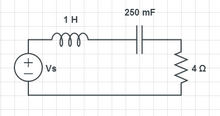Circuit Theory/Convolution Integral/Examples/example49/current
Given that the source voltage is (2t-3t2), find voltage across the resistor.

Here focused on finding current first:
Transfer Function
editsimplify(1/(4 + s + 1/(0.25*s)))
Homogeneous Solution
editsolve(s^2 + 4.0*s + 4.0,s)
There are two equal roots at s = -2, so the solution has the form:
Particular Solution
editAfter a long time attached to a unit step function source, the inductor has shorted and the capacitor has opened. All the drop is across the capacitor. The current is zero.
Initial Conditions
editSo far the full equation is:
Initial current through the series leg is zero because of the assumed initial conditions of the inductor. This means:
Assuming the initial voltage across the capacitor is zero, then initial voltage drop has to be across the inductor.
After a long period of time, the current still has to be zero so:
This means that:
The 4 is lost in the numerator of the transfer function if a transfer function is written for Vr initially. The 4 does not make it into the homogeneous solution. In second order analysis, never write a transfer function for a resistor.
Impulse Solution
editTaking the derivative of the above get:
Convolution Integral
editf := (4*exp(-2*(t-x)) - 8*(t-x)exp(-2*(t-x)))*(2*x-3*x^2); S :=int(f,x=0..t)
There will not be any constant since again, V_R(t) = 0 after a long time ... and the capacitor opens.